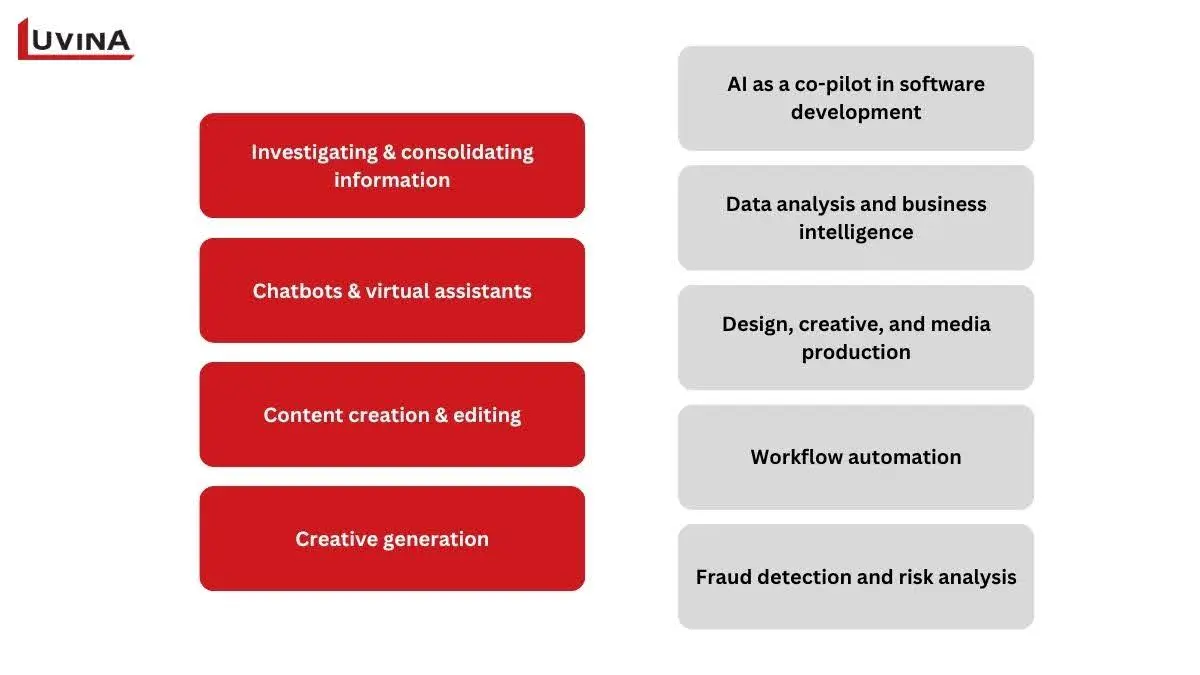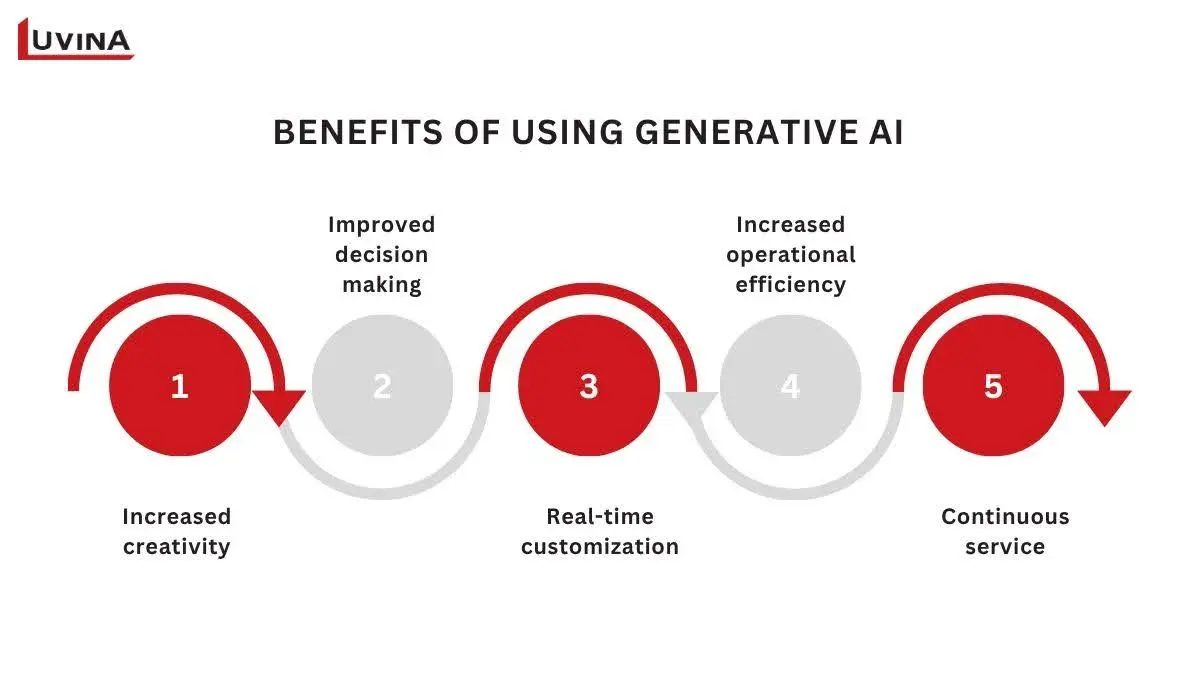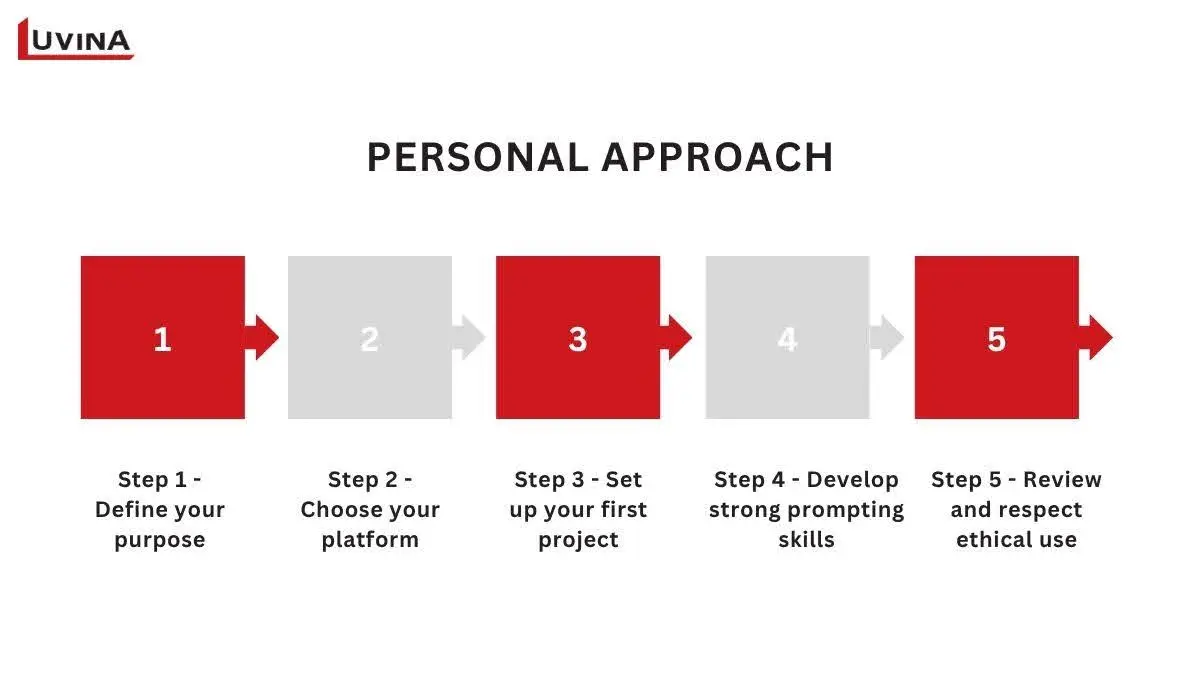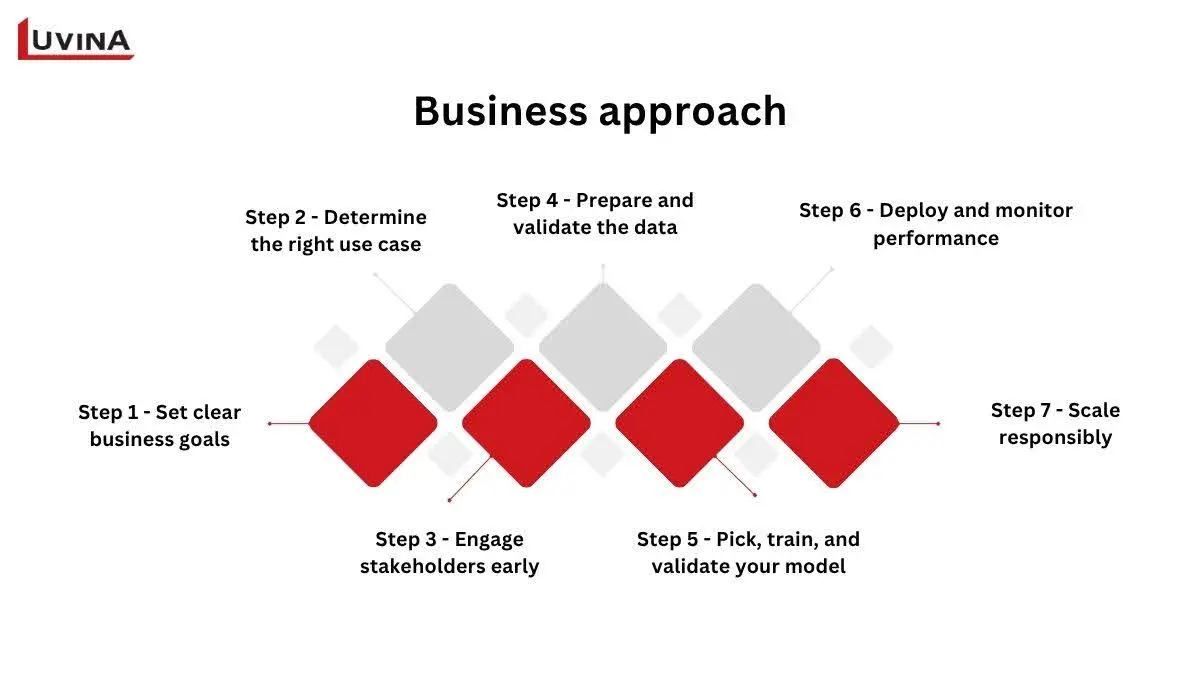Applications of generative AI are revolutionizing the way companies nowadays develop, create, and operate. Gartner says that by 2026, more than 100 million people will use generative artificial intelligence to improve their daily jobs.
To stay competitive, businesses must understand how generative AI applies across key functions. Its adoption is growing fast. The leading uses of generative artificial intelligence molding the sectors of today will be investigated in this article.
Generative AI Fundamentals (Quick Primer)
Before we go over the applications of generative AI, let’s first clarify how it works and why it matters in modern organizations:
What exactly is it?
In reaction to user commands, generative artificial intelligence generates fresh text, pictures, audio, or code. It produces unique outputs using learned patterns and predictions. It doesn’t just collect or repeat data.
How does it function?
Foundation models – large-scale AI models trained on vast datasets – drive the technology. These models help to produce coherent and contextually appropriate results by finding patterns and connections in data.
Large Language Models (LLMs)
A major subgroup of foundation models – those of OpenAI’s GPT – concentrates on language-based applications, including summarization, question answering, and technical or inventive text production.
In what area does it prosper?
Generative AI automates repetitive tasks, creates personalized content, and boosts creativity. It also turns data into insights for better decisions.
Why does it matter?
From static automation to adaptive intelligence, generative artificial intelligence lets systems that think, create, and change with their human users.
Common Applications of Generative AI
Generative artificial intelligence is changing how people and companies work, create, and communicate as applications of generative AI keep growing. Some of the most common applications of generative AI in both personal and professional contexts are listed here.

1. Personal use
- Investigating & consolidating information: Whether it’s absorbing quickly, condensing lengthy articles into short articles, or just distilling a complex topic or discussion into a neat summary for teaching and learning purposes.
- Chatbots & virtual assistants: AI creates human-like conversation and interaction, and typically have 24/7 assistance available. They will reinforce immediate response to questions, assist with scheduling, or make daily decision-making.
- Content creation & editing: Users can rapidly and efficiently produce a unique, current, and modified version of your content – from social media captions to blog ideation.
- Creative generation: With the use of gen AI programs, people can produce paintings, music, or movies – that is, explore artistic expression without requiring professional design or editing experience.
2. Professional / Business use
- AI as a co-pilot in software development: AI supports software developers in either writing, completing, or even reviewing code using tools like GitHub Copilot or ChatGPT to enhance productivity and reduce time spent doing burdensome programming tasks.
- Data analysis and business intelligence: AI allows a work grouping to make decisions more quickly, and with more information, while AI models summarize large portions of data, detect patterns, and visualize trends.
- Design, creative, and media production: Organizations can leverage generative AI to create prototypes, marketing copy, video scripts, and images for advertisements, while reducing throughput times and retaining creativity in production.
- Workflow automation: Transfers manual activities so that staff can focus on higher-value activities by automating data entry, document processing, and various workflow monitoring processes.
- Fraud detection and risk analysis: AI is particularly beneficial for banking, insurance, and e-commerce, as these systems can evaluate transaction data to identify anomalies and highlight suspicious activities.
Industry Specific Applications
The actual strength of applications of generative AI is in its capacity to change depending on the particular requirements of every sector. Below parts will cover how major industries are using this technology to create fresh possibilities and provide clear results.
1. Fintech & Banking: Key Generative AI Applications and Benefits
Among the first and most enthusiastic users of genAI applications is the financial industry, which relies heavily on data, automation, and compliance. Banks and fintech companies are improving risk management, streamlining complicated processes at an unmatched scale, and so enhancing client experience by using generative artificial intelligence.
| Applications of generative AI | Description |
|---|---|
| Investment strategy development | Analyzes market data to build optimal portfolios and enable faster trading decisions. |
| Customer communication & education | Clarify sophisticated financial products, providing customers with individualized and easily available assistance. |
| Document drafting & regulatory monitoring | Follow real-time regulatory changes, prepare policy papers, and generate reports. |
| Fraud detection | Detect suspicious activity by monitoring behavioral patterns and transaction irregularities. |
| Risk management & forecasting | Offer more profound knowledge of possible losses and investment risks, predict market volatility, and simulate economic situations. |
| Data privacy protection | Train models safely using synthetic AI-generated datasets |
2. Retail & E-commerce: Generative AI Use Cases Driving Customer Experience
Applications of generative AI are transforming how companies interpret consumers, customize interactions, and maximize operations. Retailers are using GenAI to design data-driven, smooth shopping experiences that boost sales as well as engagement.
| Applications of generative AI | Description |
|---|---|
| Personalized product recommendations | Analyzes shopping behavior to personalize recommendations and boost conversions. |
| Product and display design | Design new products, adapt to market trends, and tailor displays for each customer group. |
| Automated content generation | Creates compelling product descriptions, marketing messages, and social media posts. |
| Inventory management & supply chain optimization | Predict demand patterns, help businesses decrease excess inventory, and avoid out-of-stocks. |
| Virtual shopping assistants | Provides near real-time conversational capability to customers while answering questions and offering recommendations. |
3. Manufacturing
Businesses in the manufacturing industry are learning how to use GenAI to speed innovation, lower downtime, and improve general operating efficiency. Manufacturers may get better, quicker, and more sustainable results by using generative artificial intelligence at every step of manufacturing.
| Applications of generative AI | Description |
|---|---|
| Accelerated product design | Design tools to expeditiously generate, test, and iterate product concepts. |
| Predictive maintenance | Monitors sensor data to predict machine failures before they occur. |
| Quality control | Identify flaws by studying photographs and historical production data. |
| Production planning & inventory management | Simulate production situations, and so maximize inventory levels. |
| Supply chain optimization | Analyze transactional data to understand where the supply chain situation can be interrupted, offering new sellers or delivery methods to make the supply chain more durable. |
4. Education
In the education sector, applications of generative AI are transforming how teachers teach and students learn. Generative AI is transforming classrooms into more engaging, equitable, and efficient learning environments through personalized learning, increased automation of learning materials, and increased opportunities for adaptive learning.
| Applications of generative AI | Description |
|---|---|
| Personalized learning paths | Tracks progress to tailor lessons, exercises, and guides to each learner’s pace and style. |
| Course and curriculum design | Create syllabi, exams, and simulations for a broad range of learner needs across learners. |
| Automated educational content | Generate study guides, quizzes, scripts, and images for instructional use quickly. |
| AI tutoring and student engagement support | Assist in the moment, give feedback based on the response from the learner, which can create different ways of engaging with students. |
| Ethical learning analytics and data privacy | Maintain student privacy while supporting training for systems in educational models, allowing for an opportunity to gain feedback from data collected and fed back into models for improved equitable and inclusive practices. |
| Recovery and enhancement of legacy materials | Enhance old or low-resolution learning materials. |
5. Healthcare: Generative AI Examples in Real Life
Including generative AI examples in real life has greatly changed the healthcare sector, therefore enabling medical experts to improve diagnosis, simplify studies, and tailor patient care.
| Applications of generative AI | Description |
|---|---|
| Accelerating drug discovery and development | Analyzes molecular data to find new drugs, predict interactions, and simulate effects. |
| Personalized treatment plans | Develop customized treatment plans that improve outcomes and lessen undesirable adverse effects |
| Enhanced medical imaging | Anticipate disease development, fill missing data, and even increase image quality. |
| AI chatbots and virtual health assistants | Remind patients to take medicine, schedule appointments, and check symptoms. |
| Synthetic data for privacy and research | Generates realistic but anonymous medical datasets. |
| Automating regulatory and clinical documentation | Draft and manage compliance reports, clinical trial documentation, and submissions. |
6. Media and entertainment
One of the most energetic areas for applications of generative AI – where creativity meets automation – is the media and entertainment industry is one.
| Applications of generative AI | Description |
|---|---|
| Content creation and post-production | Helps directors, musicians, and designers to create fresh screenplays, music, and imagery. |
| Highlight generation for live events | Generates instant highlight reels for broadcasters and streaming platforms. |
| Smart content management | Helps creators and producers to rapidly find assets, recycle film, and handle intellectual property. |
| Personalized recommendations and audience insights | Suggests programming, music, or articles suited for each user based on viewer preferences and engagement statistics. |
| Creative assistance in music and design | Help designers play with visual styles, create concept art, or polish current ideas without beginning from scratch; help musicians write tunes or remix songs. |
7. Travel
To provide quicker, more tailored travel, the tourism industry is adopting applications of generative AI.
| Applications of generative AI | Description |
|---|---|
| Identity verification | Enables quick, secure passenger verification to reduce wait times. |
| Personalized recommendations | Recommend personalized things to do, places to stay, and destinations. |
| Customer service & content creation | Generate a marketing image for destinations and create destination content, facilitate bookings and answer questions. |
Benefits of Generative AI Applications for Businesses
Organizations that investigate how to use generative AI effectively uncover not only increased efficiency but also a great array of strategic benefits.

- Increased creativity: Generative AI enables creative professionals to generate multiple ideas, concepts, or prototypes that would be impossible in seconds, leading to better and refreshed work on the side of the writer, designer, or marketer.
- Improved decision making: AI systems study a huge dataset of patterns to back their recommendation for data-supported decision making.
- Real-time customization: AI systems not only study previous engagement patterns, but also engage real-time data for engagement and satisfaction, while customizing client-recommended content, suggestions, and experience.
- Increased operational efficiency: The applications of generative AI are automating the mundane, allowing teams to spend more time innovating instead of the manual process and precedent of processes.
- Continuous service: AI systems can provide continual service, functioning in continuous support of unlimited provision and processes in all time zones across the globe, whereas humans cannot work around the clock.
Risks & Limitations of Using Generative AI Applications
Though the applications of generative artificial intelligence have opened hitherto unheard-of possibilities for innovation, they also bring complicated hazards that corporations and developers have to expertly handle.
- Misleading and inaccurate results: Generative AI models can output false or misleading content (sometimes referred to as “hallucinations”). Although errors often prove to be correct, they can lead to some operational errors or misinformation if not rechecked.
- Influence of bias/fairness: AI systems are trained and learn patterns based on existing data. Consequently, they can replicate or amplify existing societal and cultural biases.
- Variance in output: The generative nature of gen AI applications means the same input will create different outputs, leading to uncertainty in situations when consistency is expected or desired (for example, in automation for customer support).
- Transparency issues: Most models are referred to as “black boxes” and do not allow for a transparent, simplified explanation of how results are generated. Thus, obscurity builds mistrust and increases the difficulty of complying with regulations across industries.
- Security and privacy risks: Generative-type technologies (applications) can generate content, videos, images, phishing content, deep fakes, and IP theft, in addition to the possibility of users inadvertently disclosing sensitive data or information. User education and responsive and rigid data governance are critical protective measures reported.
- Deepfake manipulation: The growth of synthetic media is concerning. Detection is improving, but awareness and authentication serve as the best protection.
How to Use Generative AI (Step‑by‑Step)
Helpful applications of generative AI require clarity of purpose and planned execution. If you’re a business using artificial intelligence as a supplement to activities or an individual testing it for personal improvement, a structured approach ensures impact and safety.
1. Personal approach
Using GenAI application technologies can help people increase productivity, simplify learning, and improve inventiveness. Here is how to begin:

- Step 1 – Define your purpose: Start by determining what you wish to accomplish – from generating ideas and producing visuals to studying new subjects and writing aids. Choosing tools best suited to your aims is made possible by having a clear objective.
- Step 2 – Choose your platform: Select systems that are simple and practical for your needs. For example, DALL-E or Midjourney may supply the images, and ChatGPT may provide writing or research assistance. If you are just getting started, those are good options to try before you move on to more challenging systems like TensorFlow, Pytorch, and open-source models to create your own generative AI.
- Step 3 – Set up your first project: Opening an account, viewing lessons, and beginning with modest jobs to become familiar with the features of each tool. Learning from seasoned users or becoming a member of internet AI groups will help you acquire useful insights and overcome early obstacles.
- Step 4 – Develop strong prompting skills: You should now get to work on experimenting with your prompting skills so that you can write prompts that are not only contextual but specific. Specific and contextual prompts produce unambiguously better results; for example, “Write a blog post of at least 200 words about eco-friendly travel in Southeast Asia,” usually just gets a better response when compared to the more general. Keep practicing experimentation, evaluate the results, and then edit your initial query until you establish a logical flow.
- Step 5 – Review and respect ethical use: Always ensure the information provided is accurate, fix any errors, and continually respect privacy. Do not publish generative AI-generated content that is misleading to the audience or authenticates data that breaks copyright. The use of generative AI is for best results if it is appropriately controlled to allow for creative, safe, and reliable engagement with artificial intelligence.
2. Business approach
Organizations may improve efficiency, unleash innovation, and strengthen decision-making by means of integrating generative artificial intelligence applications, only however with sufficient planning and control.

- Step 1 – Set clear business goals: Determine precise areas where artificial intelligence might generate quantifiable benefit, including automating customer care, improving product design, or speeding content output, and set clear company goals. Match every project to general corporate goals and set precise KPIs to monitor outcomes.
- Step 2 – Determine the right use case: Focus on the cases that will have the most impact on a business, can be managed within a reasonable complexity, have perceived technical feasibility, and can be articulated as a use case. Start with a smaller pilot to test and then scale up to ensure alignment with current systems.
- Step 3 – Engage stakeholders early: Engaging cross-functional teams early in the process will help with stakeholder engagement. You will work collaboratively to ensure the AI solution meets operational needs and is supported operationally and strategically.
- Step 4 – Prepare and validate the data: Data quality will be a key determinant of success, so you want to prepare and validate the data to ensure it’s usable. Devise governing principles, clean and normalize the available data, integrate different data sources, and do an audit of those data sources. Data engineers will primarily oversee the reliability and regulatory compliance.
- Step 5 – Pick, train, and validate your model: Select a foundation model that will provide what you need – that is, pretrained or bespoke. With respect to governance structures used to ensure compliance and confidence, evaluate severe testing to determine performance, accuracy, and bias.
- Step 6 – Deploy and monitor performance: With assistance from IT and developers, incorporate the model into your production setting in step six. Establish feedback mechanisms to gather user feedback and constantly raise performance, correctness, and user experience.
- Step 7 – Scale responsibly: Once shown to work, expand your applications of generative AI throughout more divisions or processes. Ensure AI stays in line with your company’s objectives by means of robust ethical standards, transparent governance, and constant optimization.
Getting Started Checklist For Business
Recommended to initiate with a well-articulated, structured plan, ensuring preparedness, due diligence to ethical use and responsible governance, and establish a method of measures, before scaling applications of generative AI. Here’s a brief checklist to assist you in your journey:
- Recognize scalable opportunities: Look for scalable opportunities offered by gen AI applications, provided an initial investment is made- such as content development, workflow efficiencies, and amplified consumer engagement.
- Assess data readiness: Audit data health, access, and compliance policies to ensure that you can utilize high-quality data to support effective Generative AI training, modeling, and decision making.
- Plan three three-phased deployment: Identify meaningful cases in 3 phases with actionable objectives, resources, and a plan for an interim report before /proceeding into full adoption.
- Empower workforce: Allow for learning how to use generative AI and encourage experimentation as a part of a team will build the confidence to consider artificial intelligence as part of the team’s routine workflow.
- Responsible governance: Design ethical guidelines, including content moderation and oversight, to assist in the management of risk to maintain trust and responsibility in governance.
- Measure and refine: Track performance indicators, gather input, and constantly improve systems to maximize the economic value of GenAI.
FAQ
What is generative AI?
Generative AI is a technology that creates new content by learning from existing data. It powers many applications of generative AI that help automate, personalize, and enhance business operations.
Can generative AI replace human workers?
No. Most gen AI applications are built to support, not replace, people. They handle repetitive work so employees can focus on creative and strategic tasks. Nevertheless, as AI boosts individual productivity, a reduction in the overall demand for human staff is a likely consequence.
How can businesses start using generative AI?
Start small: choose a clear goal, test existing tools, ensure data readiness, and scale what works. Learning how to use generative AI effectively requires good data, employee training, and strong governance.
Are there ethical concerns when using generative AI?
Yes. Companies must address data privacy, bias, transparency, and responsible use to maintain trust and comply with regulations.
Can generative AI be used in any industry?
Yes. The applications of generative AI span healthcare, finance, retail, media, and more.
What are the common challenges in implementation?
Key hurdles include data quality, bias control, governance setup, and ensuring accuracy in AI outputs.
How do you measure success with generative AI?
Track metrics like cost savings, productivity gains, or customer satisfaction. Regular reviews and optimization ensure lasting business value.
Conclusion
The applications of generative AI shown in this book emphasize its ability to improve productivity and promote wise decisions. Companies have to strike technology with human intuition and moral behavior to successfully use it.
Contact Luvina right now for professional advice and customized implementation assistance, should your company be prepared to investigate applications of generative artificial intelligence.
Resources
- https://www.coursera.org/articles/generative-ai-applications
- https://research.aimultiple.com/generative-ai-applications/
- https://www.ibm.com/think/topics/generative-ai
- https://www.gartner.com/en/topics/generative-ai
- https://aws.amazon.com/what-is/generative-ai/
- https://hatchworks.com/blog/gen-ai/generative-ai-beginners/
- https://www.ibm.com/think/insights/step-by-step-guide-generative-ai-for-your-business
- https://www.capicua.com/blog/generative-ai-use-cases









Read More From Us?
Sign up for our newsletter
Read More From Us?
Sign up for our newsletter